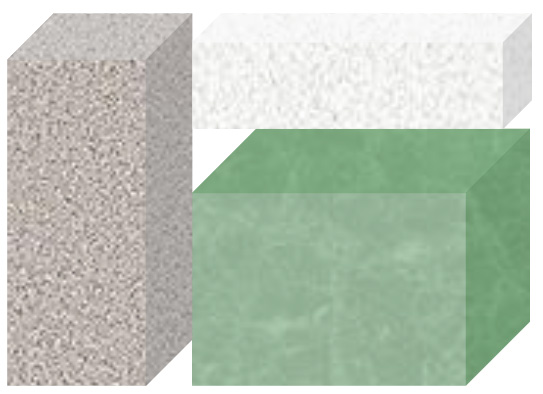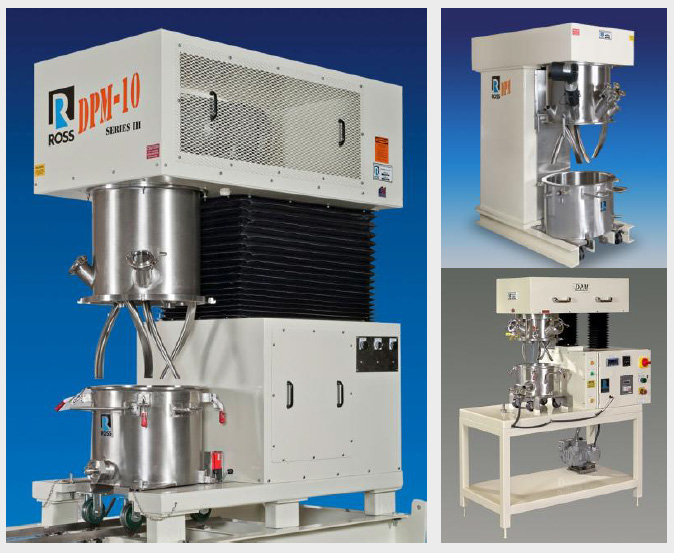Tech Report
Recommended Mixing Equipment for Specialty Concrete

Application Summary
Specialty concrete has become a popular material for countertops, sinks, vanities, floors and walls. A highly versatile product, it offers end users many choices in terms of texture, effect, color, shape and strength.
Fast, accurate and repeatable mixing of the cement, lightweight aggregates, water and additives is necessary to produce consistently high-quality specialty concrete.
Ross Double Planetary Mixers
Double Planetary Mixers are ideal for preparing specialty concrete mixtures. Traditional designs move materials by rotating two rectangular-shaped paddles on their respective axes as they orbit on a common axis. The blades contact virtually every point of the batch in just 36 revolutions, imparting a very thorough but gentle mixing action. Newer design helical blades, such as the Ross High Viscosity "HV" Blades, offer improved mixing and easier handling of viscous materials.
A typical batch in the Double Planetary Mixer may start with blending of the dry ingredients: cement powder, glass, fibers, silica and other minerals. Water is then added through a charge port on the mixer cover as the blades continue to agitate the batch. Certain formulations benefit from processing under vacuum for a certain period to release any air bubbles within the mixture and minimize porosity in the final product.
Variable speed control is an important feature of the Double Planetary Mixer. The planetary blades inherently deliver low-shear agitation but running at lower speeds whenever possible helps to reduce wear on the stainless steel components. The finished mixture is usually a flowable paste which can be discharged by gravity through a bottom valve on the mix vessel and poured directly into molds. The Double Planetary Mixer is cleaned quite easily through a quick wipe down with warm water, leaving well enough time before the concrete can set on the mixer surfaces.
Just a few other applicationstypically produced inRoss Double Planetary Mixers:
- Battery Pastes
- Bone Graft Substitutes
- Caulking Compounds
- Collagen Solutions
- Dental Composites
- Dilatant Materials
- Engineered Composites
- Epoxies
- Heat Sink Compounds
- Lubricants
- Molding Compounds
- Pharmaceutical Gels
- Polymer Concrete
- Potting Compounds
- Propellants
- Refractory Cements
- Rubber Adhesives
- Silicones
- Solder Paste
- Syntactic Foams
- Thick Film Inks
- Urethane Sealants

Some Advantages of Ross Double Planetary Mixerswith High Viscosity "HV" Blades
- Fast and accurate mixing. With their precisely angled helical contour, HV blades generate a unique mixing action: each sweeping curve firmly pushes batch material forward and downward, keeping it within the mixing zone at all times. The flush discharge valve on the mix vessel eliminates any dead spots where batch materials can stagnate.
- Cleanability. Unlike horizontal blenders equipped with a ribbon or paddle agitator, the product-wetted surfaces of a Double Planetary Mixer are easier and faster to clean. In addition, there are no shaft seals, bearings, packing glands or stuffing boxes submerged in the product zone. The agitators are raised and lowered by a hydraulic lift allowing complete access for cleaning between batches.
- Flexibility. High Viscosity Blades are used for processing a wide range of materials and rheologies from dry powders and wet granulations to flowable pastes, delicate gels and extremely viscous compounds.
- Change can design. Interchangeable mix cans may be designated to particular formulations or colors. This feature reduces the risk for cross-contamination between sensitive batches while enabling semi-continuous operation when one mixer is used with multiple vessels.
- Vacuum capability. Mixing under vacuum in a Double Planetary Mixer is a cost-effective technique for quickly preparing void-free mixtures in a highly repeatable manner.